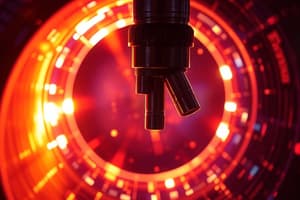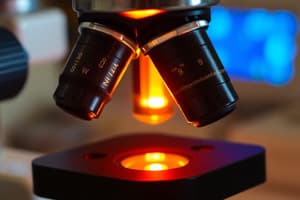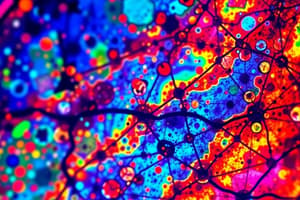Podcast
Questions and Answers
What is the primary purpose of immersion oil in oil-immersion objectives?
What is the primary purpose of immersion oil in oil-immersion objectives?
- To act as a lubricant for the lens
- To increase magnification
- To reduce light refraction (correct)
- To preserve the slide sample
Which component of the microscope is primarily responsible for adjusting focus?
Which component of the microscope is primarily responsible for adjusting focus?
- Body tube
- Fine adjustment (correct)
- Coarse adjustment (correct)
- Ocular lens
What characteristic distinguishes phase-contrast microscopes from brightfield microscopes?
What characteristic distinguishes phase-contrast microscopes from brightfield microscopes?
- Enhanced contrast of unstained structures (correct)
- Ability to view stained slides
- Higher magnification
- Requirement of immersion oil
What does the term 'working distance' refer to in microscopy?
What does the term 'working distance' refer to in microscopy?
Which of the following statements is true regarding the focusing mechanisms in microscopes?
Which of the following statements is true regarding the focusing mechanisms in microscopes?
What type of microscope is most commonly used in clinical laboratories?
What type of microscope is most commonly used in clinical laboratories?
What is the effect of the phase contrast system on light?
What is the effect of the phase contrast system on light?
Which type of lens combination does a brightfield microscope typically use?
Which type of lens combination does a brightfield microscope typically use?
What unique feature does an interference-contrast microscope use to enhance visibility of fine details?
What unique feature does an interference-contrast microscope use to enhance visibility of fine details?
In which scenario would a polarizing microscope be least useful?
In which scenario would a polarizing microscope be least useful?
What is the principle behind the appearance of specimens under a darkfield microscope?
What is the principle behind the appearance of specimens under a darkfield microscope?
What is a key characteristic of a fluorescence microscope compared to other types?
What is a key characteristic of a fluorescence microscope compared to other types?
How does an electron microscope primarily differ from optical microscopes?
How does an electron microscope primarily differ from optical microscopes?
What is the main function of the analyzer in a polarizing microscope?
What is the main function of the analyzer in a polarizing microscope?
Which type of microscope is specifically mentioned for observing spirochetes?
Which type of microscope is specifically mentioned for observing spirochetes?
What type of imaging does birefringence facilitate in a polarizing microscope?
What type of imaging does birefringence facilitate in a polarizing microscope?
What is the primary function of the stage in a microscope?
What is the primary function of the stage in a microscope?
Which component of the microscope directs and focuses light onto the specimen?
Which component of the microscope directs and focuses light onto the specimen?
What does the numerical aperture (NA) of a microscope indicate?
What does the numerical aperture (NA) of a microscope indicate?
What is the role of the ocular lens in a microscope?
What is the role of the ocular lens in a microscope?
How does the aperture iris diaphragm affect the observation process?
How does the aperture iris diaphragm affect the observation process?
Which of the following statements about the total magnification of a microscope is correct?
Which of the following statements about the total magnification of a microscope is correct?
What is a consequence of using a microscope with a high numerical aperture?
What is a consequence of using a microscope with a high numerical aperture?
Which part of the microscope is responsible for its stability and support structure?
Which part of the microscope is responsible for its stability and support structure?
Flashcards are hidden until you start studying
Study Notes
Types of Microscopes (Illumination Systems)
-
Interference-Contrast Microscope
- Produces three-dimensional images without special staining.
- Ideal for wet preparations like urine sediment.
- Uses a Wollaston prism in the condenser to enhance detail.
-
Polarizing Microscope
- Utilizes polarizers to filter light waves, allowing only one orientation to pass.
- Includes an analyzer above the specimen for enhanced visualization.
- Birefringence allows objects to polarize light, appearing bright against a dark background.
-
Darkfield Microscope
- Employs a darkfield condenser to make specimens appear light against a dark background.
- Particularly useful for observing spirochetes in infections such as leptospirosis or syphilis.
-
Fluorescence Microscope
- An advanced darkfield microscope with a barrier filter for specific fluorescence wavelengths.
- Only objects that fluoresce emit light, allowing for selective visualization.
-
Electron Microscope
- Provides magnification up to 50,000x.
- First developed in 1931 by Max Knoll and Ernst Ruska.
- Digital models facilitate live viewing on screens.
Basic Microscope Concepts
-
Magnification
- Total magnification is the product of ocular and objective lens magnifications.
- Images are inverted and reversed.
-
Resolution
- Defines the smallest distinguishable distance between objects, quantified by numerical aperture (NA).
Microscope Structure
-
Parts of the Microscope
- Base: Stable, horseshoe-shaped foundation.
- Arm: Supports the magnifying system.
- Stage: Platform for specimen placement.
-
Illumination System
- Light Source: Bulb providing illumination.
- Condenser: Focuses light onto the specimen.
- Aperture Iris Diaphragm: Regulates light intensity through the specimen.
-
Magnification System
- Ocular (Eyepiece): Magnifies the image from the objective lens.
- Oil-Immersion Objective: 100x magnification, uses immersion oil for clarity.
-
Focusing System
- Body Tube: Pathway for light to the ocular lens.
- Coarse Adjustment: Quickly adjusts focus over a wide range.
- Fine Adjustment: Offers precise control over focus adjustments.
Additional Types of Microscopes
-
Brightfield Microscope
- Most common in clinical labs, using standard two-lens system.
-
Phase-Contrast Microscope
- Enhances unstained structures without dehydration.
- Increases contrast, making refractive index differences more noticeable.
- Slows light speed by one-fourth wavelength, enhancing visual differentiation among structures.
Studying That Suits You
Use AI to generate personalized quizzes and flashcards to suit your learning preferences.




